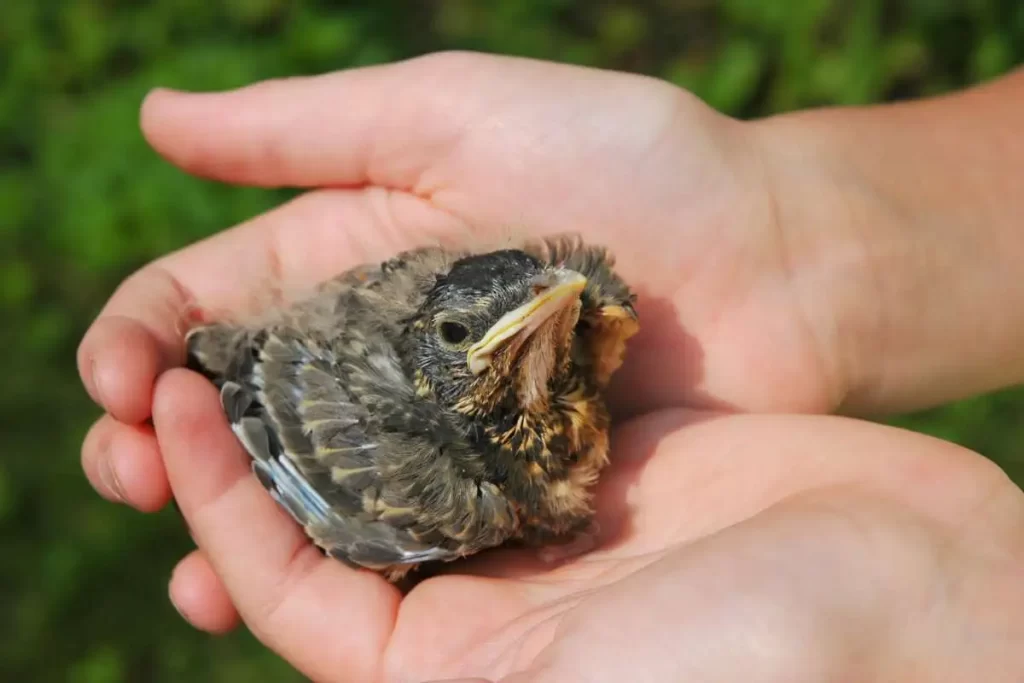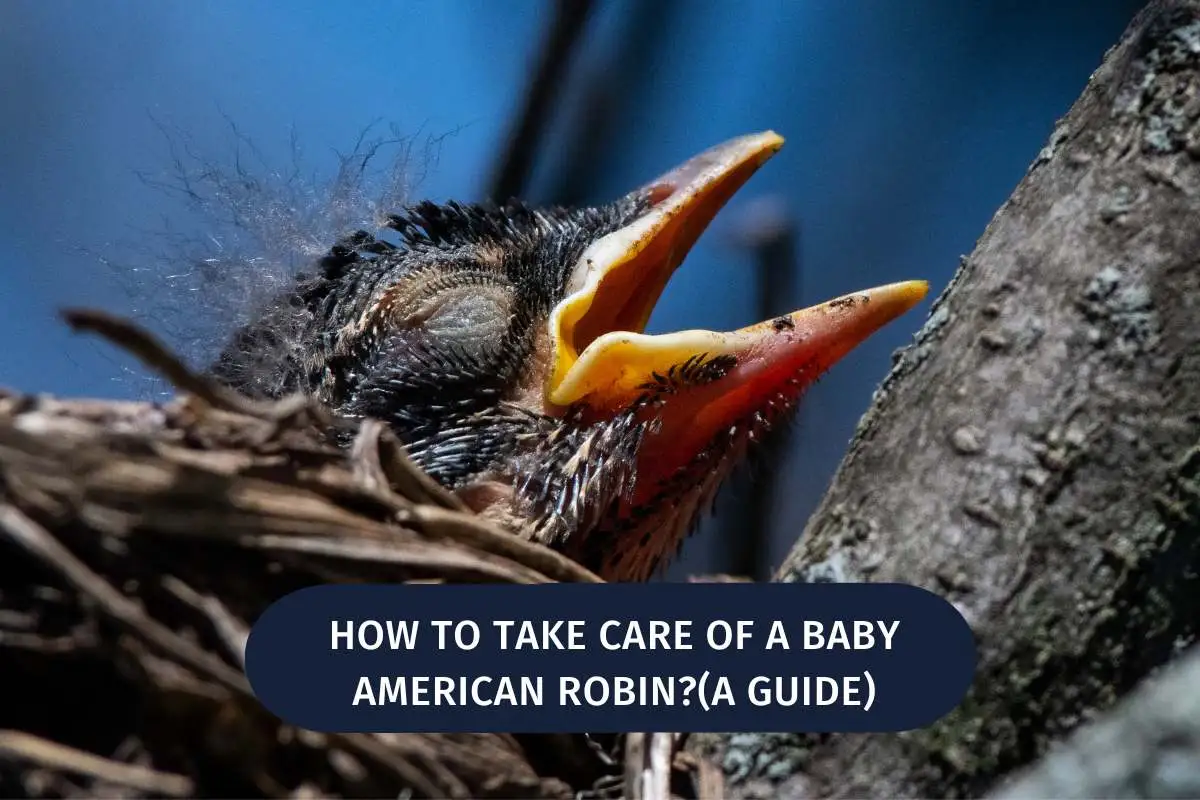If you find an American baby robin, the best thing to do is to search for the nest and place it in the nest carefully. The mother robin is likely nearby and will continue to care for it.
However, if the baby robin appears injured or sick, or if it is in immediate danger, you can carefully pick it up using gloves or a towel. Know more about how to take care of a baby American robin from the table below:
| Step | Description |
| 1 | Place the baby robin in a small, secure container with air holes. |
| 2 | Keep the container in a warm place (at room temperature) and away from direct sunlight and drafts. |
| 3 | Feed baby robin food using a dropper or by hand. You can also offer them small insects, such as crickets or mealworms. |
| 4 | Monitor the baby robin’s condition and behavior. If it appears to be healthy and active, it can be released back into the wild once it is fully feathered and able to fly. |
| 5 | If the baby robin is not thriving, or if you are unable to care for it, contact a local wildlife rehabilitation center for assistance. |
It is important to note that it is illegal to keep wild birds as pets in most areas. If you find a baby robin, it is best to leave it in its natural environment and provide assistance only if necessary.
How often to feed a baby robin?
If you are caring for an American baby robin, it is important to provide regular meals to ensure that it is getting the nutrition it needs to grow and thrive.
The frequency of feedings will depend on the age and size of the baby robin, but as a general guideline, you should aim to feed it every few hours.
Follow the step below to feed an American baby robin:
- Gather the appropriate food for the baby robin. Insects, such as crickets or mealworms, are a good source of protein. You can also offer small pieces of fruit or berries as a source of energy.
- Prepare the food by placing it on a small plate.
- Use a small spoon or tweezers to offer the food, but be careful not to force the baby robin to eat if it is not interesting.
- Repeat the feeding process every few hours or as needed to ensure that the baby robin is getting enough to eat.
- Monitor the baby robin’s condition and behavior to ensure that it is eating well and growing properly.
Can baby robins eat dried mealworms?
It is not recommended to feed baby robins dried mealworms. Baby robins should be fed a diet of insects, such as caterpillars, beetles, and crickets, as well as small amounts of fruit and berries.
Dried mealworms are not a natural part of a baby robin’s diet and can be difficult for them to digest. It is best to provide fresh, live insects for baby robins to eat.
Do baby robins eat at night?
It is not uncommon for baby robins to eat at night, especially during the early stages of their development when they require a lot of food to fuel their growth.
During this time, the parents will typically bring food to the nest for the babies to eat. As the babies get older and are able to leave the nest, they will start to forage for food on their own, which may include eating at night.
However, in captivity, you can offer at least one mean every night.
What do you do if you find a baby robin?
If you find a baby robin, the best thing to do is to leave it alone or place it in their nest, if they are too young.
Baby birds are often unable to fly when they first leave the nest, and it is natural for them to spend some time on the ground as they learn to fly and gain strength.
The parents will continue to care for the baby and provide it with food, even while it is on the ground.
Should I feed baby robin water?
In the wild, baby amaerican robins do not eat direct water. They consume water from the food they eat. The parents will provide the baby with the water it needs by bringing it food that is high in moisture, such as insects and fruit.
However, if you are petting baby robins at home, you can provide them water if they are more than 15 days old. You can also contact a veteran; they have the experience to properly care for the bird and ensure that it receives the appropriate nutrition and hydration.
How do you save a baby robin?
If you find a baby robin that appears to be in need of help, here are five steps you can follow to try and save it:
- Determine if the baby robin actually needs help. If it is uninjured and able to move around, it is likely doing fine and just learning to fly. In this case, it is best to leave it alone and let the parents continue to care for it.
- If the baby robin is injured or unable to move, it will need to be rescued. Handle the bird carefully, using gloves or a towel to avoid leaving your scent on it.
- Place the baby robin in a small, secure box or container with ventilation holes and a soft, clean cloth for it to rest on.
- Keep the baby robin warm and quiet, away from loud noises and direct sunlight. Do not give it any food or water, as this can be dangerous for a young bird.
- Contact a wildlife rehabilitator as soon as possible for further instructions and to arrange for the baby robin to receive proper care. It is important to do this quickly, as baby birds can
What does a baby robin look like?

Baby robins, also known as hatchlings or nestlings, are small and have soft, fluffy feathers. They are typically covered in down and have a brown or beige color on their backs and wings, with a white or pale-yellow underside.
Their beaks are short and pointed, and their legs and feet are also typically a pale yellow or beige color. As they grow and develop, their feathers will become more distinct, and they will begin to resemble their adult counterparts.
Did I answer everything you need to know about how to take care of a baby american robin?
Caring for an American baby robin is simple; if you find this bird under a tree or garden, the first thing you need to do is to look for the nest. When you find the nest, place the chicks in the nest, and the parent robin will take care of their baby.
However, if you don’t find any nest, you can place the baby birds in a box on a towel or wool. Feed them every few hours. Do not overfeed them. Learn more about taking care of baby American robin from this article.

